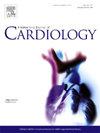桥本甲状腺炎与非缺血性心肌病的因果关系及炎症因子的介导作用:来自遗传关联分析的证据。
IF 3.2
2区 医学
Q2 CARDIAC & CARDIOVASCULAR SYSTEMS
引用次数: 0
摘要
背景:既往研究报道桥本甲状腺炎(HT)可能与非缺血性心肌病(NICM)相关;然而,因果关系仍有待阐明。在这里,我们旨在通过孟德尔随机化(MR)研究HT和NICM之间的因果关系,并探讨炎症细胞因子在这种关联中的潜在介导作用。方法:基于全基因组关联研究汇总数据集进行双向双样本MR、多变量MR和中介MR分析,并通过多灵敏度分析方法进一步支持MR结果。结果:我们提供的遗传证据表明,HT可以单向增加NICM的风险(优势比[OR]: 1.09, 95 %置信区间[CI]: 1.03-1.15, P = 0.001)。在校正了体重指数、高血压、血糖水平、几种血脂异常、饮酒、心脏瓣膜问题、甲状腺功能、心率和心律失常等多种潜在心血管危险因素后,HT对NICM的因果影响仍具有统计学意义。进一步的中介MR分析结果显示,γ干扰素(γ interferon, MIG)诱导的单因子可以作为中介(OR = 1.026,95 % CI = 1.006-1.052),约占HT患者NICM风险增加的28.8 %。结论:我们的研究提出了HT与NICM之间的因果关系,以及MIG在这一过程中的介导作用,突出了HT患者心肌损伤评估的重要性,为高危患者的靶向治疗提供了新的见解。本文章由计算机程序翻译,如有差异,请以英文原文为准。
Causal relationship between Hashimoto's thyroiditis and non-ischemic cardiomyopathy and the mediating role of inflammatory cytokines: Evidence from genetic association analysis
Background
Previous studies report that Hashimoto's thyroiditis (HT) may be associated with non-ischemic cardiomyopathy (NICM); However, the causal relationship remains to be elucidated. Here, we aimed to investigate the causal relationship between HT and NICM through Mendelian randomization (MR) and explore the potential mediating role of inflammatory cytokines within this association.
Methods
The bidirectional two-sample MR, multivariable MR and mediation MR analyses were conducted based on genome-wide association study summary datasets, and MR results were further supported by multiple sensitivity analysis methods.
Results
We presented genetic evidence that HT could unidirectionally increase the risk of NICM (odds ratios [OR]: 1.09, 95 % confidence intervals [CI]: 1.03–1.15, P = 0.001). After adjusting for multiple potential cardiovascular risk factors such as body mass index, hypertension, blood glucose levels, several dyslipidemias, alcohol consumption, heart valve problem, thyroid function, heart rate and arrhythmia, the causal effect of HT on NICM remained statistically significant. Further mediation MR analysis results showed that monokine induced by gamma interferon (MIG) could act as a mediator (OR = 1.026, 95 % CI = 1.006–1.052), accounting for about 28.8 % of the increased risk of NICM in patients with HT.
Conclusions
Our study proposes a causal relationship between HT and NICM, as well as the mediating role of MIG in this process, highlighting the importance of evaluating myocardial damage in patients with HT and providing new insights into the targeted treatment for high-risk patients.
求助全文
通过发布文献求助,成功后即可免费获取论文全文。
去求助
来源期刊

International journal of cardiology
医学-心血管系统
CiteScore
6.80
自引率
5.70%
发文量
758
审稿时长
44 days
期刊介绍:
The International Journal of Cardiology is devoted to cardiology in the broadest sense. Both basic research and clinical papers can be submitted. The journal serves the interest of both practicing clinicians and researchers.
In addition to original papers, we are launching a range of new manuscript types, including Consensus and Position Papers, Systematic Reviews, Meta-analyses, and Short communications. Case reports are no longer acceptable. Controversial techniques, issues on health policy and social medicine are discussed and serve as useful tools for encouraging debate.
 求助内容:
求助内容: 应助结果提醒方式:
应助结果提醒方式:


